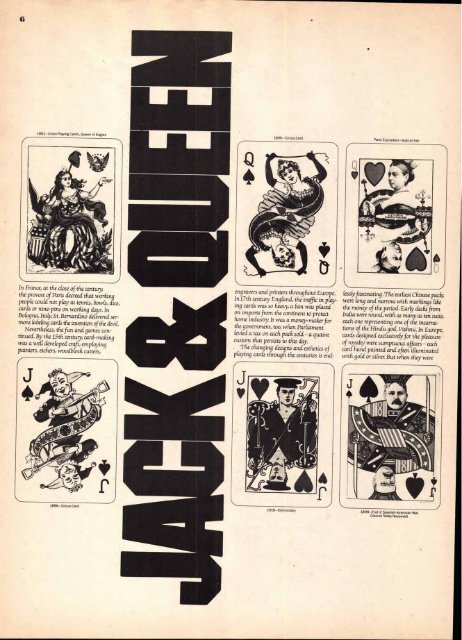Volume 8–4 (Low Res).pdf - U&lc
Volume 8–4 (Low Res).pdf - U&lc
Volume 8–4 (Low Res).pdf - U&lc
Create successful ePaper yourself
Turn your PDF publications into a flip-book with our unique Google optimized e-Paper software.
6<br />
In France, at the close of the century,<br />
the provost of Paris decreed that working<br />
people could not play at tennis, bowls, dice,<br />
cards or nine-pins on working days. In<br />
Bologna, Italy, St. Bernardino delivered sermons<br />
labeling cards the invention of the devil.<br />
Nevertheless, the fun and games continued.<br />
By the 15th century, card-making<br />
was a well developed craft, employing<br />
painters, etchers, woodblock. cutters,<br />
engravers and printers throughout Europe.<br />
In17th century England, the traffic in playing<br />
cards was so heavy, a ban was placed<br />
on imports from the continent to protect<br />
home industry. It was a money-maker for<br />
the government, too, when Parliament<br />
levied a tax on each. pack. sold- a quaint<br />
custom. that persists to this day.<br />
. The changing designs and esthetics of<br />
playing cards through the centuries is end-<br />
fess cyfasciriating . The earliest Chinese packs<br />
were long and narrow, with markings like<br />
the money of the period. Early decks from<br />
India were round, with as many as ten suits,<br />
each one representing one of the incarnations<br />
of the Hindu god, Vishnu. In Europe,<br />
cards designed exclusively for the p leasure<br />
of royalty were sumptuous affairs - each<br />
card hand painted and often illuminated<br />
with gold or silver. But when they were
















